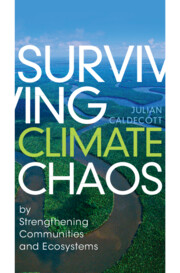Book contents
- Surviving Climate Chaos
- Surviving Climate Chaos
- Copyright page
- Dedication
- Contents
- Preface
- Acknowledgements
- Part I Context, Tools and Systems
- Part II Understanding Climate Chaos
- Part III Practical System Strengthening
- Part IV Global Perspectives
- Part V Conclusions
- 12 Designing and Evaluating Adaptation Investments
- 13 Adaptive Thinking, Feeling and Acting
- Abbreviations and Acronyms
- References
- Index
12 - Designing and Evaluating Adaptation Investments
from Part V - Conclusions
Published online by Cambridge University Press: 02 September 2021
- Surviving Climate Chaos
- Surviving Climate Chaos
- Copyright page
- Dedication
- Contents
- Preface
- Acknowledgements
- Part I Context, Tools and Systems
- Part II Understanding Climate Chaos
- Part III Practical System Strengthening
- Part IV Global Perspectives
- Part V Conclusions
- 12 Designing and Evaluating Adaptation Investments
- 13 Adaptive Thinking, Feeling and Acting
- Abbreviations and Acronyms
- References
- Index
Summary
Judgements on design and performance must be based on transparent definitions and evidence. Complex systems like communities and ecosystems can best be strengthened in certain specific ways, based on how systems work and what harms them. Design quality is high if an intervention is based on a rational theory of change supported by plausible assumptions that are strongly linked in a chain of causality. To help with surviving climate chaos a project must also pay attention to social and ecological homeostats (forums, webs of life), foundations (tenure, accountability, structure, integrity) and measures to shield, validate and renew key system elements (homelands, myths, languages and forums for social systems; nature reserves, flagship species and targeted protection and restoration for ecological ones). Design and performance scores (between perfection and worthlessness for multiple criteria) are used to highlight strengths and weaknesses within projects and across portfolios. Adaptation investments are located in a matrix of qualities (relevance, potency, coherence) and dimensions (governance, ecology, knowledge, adaptive synthesis). The co-benefits of each investment for multiple other objectives are potentially very important and must not be neglected.
Keywords
- Type
- Chapter
- Information
- Surviving Climate Chaosby Strengthening Communities and Ecosystems, pp. 279 - 307Publisher: Cambridge University PressPrint publication year: 2021

